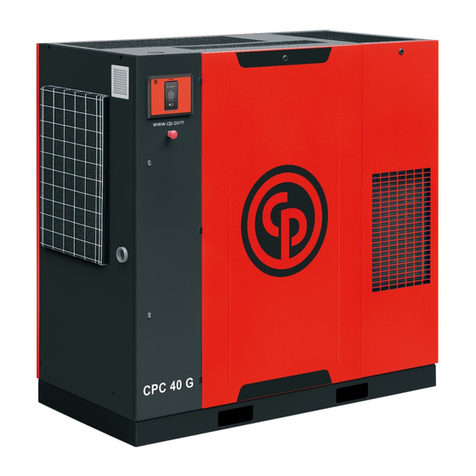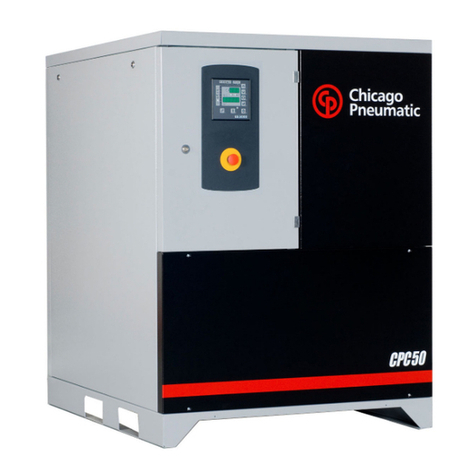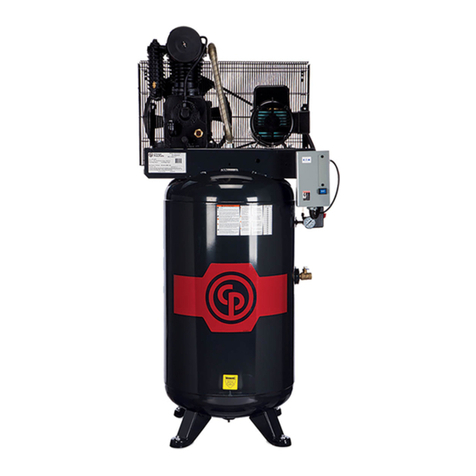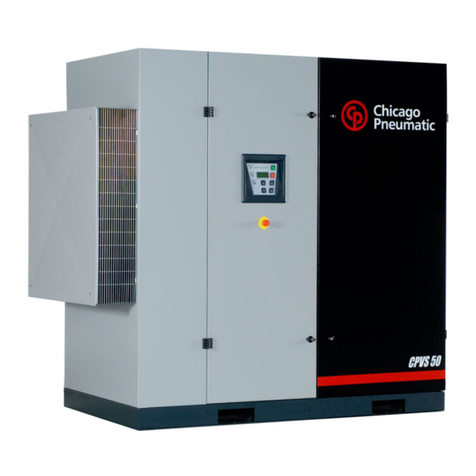
6
11. The electrical connections must correspond to the
applicable codes. The machines must be earthed and
protected against short circuits by fuses in all phases. A
lockable power isolating switch must be installed near
the compressor.
12. On machines with automatic start/stop system or if
the automatic restart function after power failure is
activated, a sign stating “This machine may start without
warning” must be axed near the instrument panel.
13. In multiple compressor systems, manual valves must be
installed to isolate each compressor. Non-return valves
(check valves) must not be relied upon for isolating
pressure systems.
14. Never remove or tamper with the safety devices, guards
or insulation tted on the machine. Every vessel or
auxiliary installed outside the machine to contain air
above atmospheric pressure must be protected by a
pressure relieving device or devices as required.
15. Piping and other parts with a temperature above 80 °C
(176 °F) that may be accidentally touched in normal
operation must be guarded or insulated. Other high
temperature piping must be clearly marked.
16. For water-cooled machines, the cooling water system
installed outside the machine has to be protected by
a safety device with set pressure according to the
maximum cooling water inlet pressure.
17. If the ground is not level or can be subject to variable
inclination, consult the manufacturer.
Also consult following safety precautions: Safety
precautions during operation and Safety precautions
during maintenance.
These precautions apply to machines processing or
consuming air or inert gas. Processing of any other
gas requires additional safety precautions typical to
the application not included herein.
Some precautions are general and cover several
machine types and equipment; hence, some statements
may not apply to your machine.
1.3 Safety precautions during operation
All responsibility for any damage or injury resulting
from neglecting these precautions, or non-observance
of the normal caution and care required for installation,
operation, maintenance and repair, even if not expressly
stated, will be disclaimed by the manufacturer.
General precautions
1. The operator must employ safe working practices
and observe all related work safety requirements and
regulations.
2. If any of the following statements does not comply with
the applicable legislation, the stricter of the two shall
apply.
3. Installation, operation, maintenance and repair work
must only be performed by authorized, trained and
specialized technicians.
4. The compressor is not considered capable of producing
breathable air. To obtain breathable air, the compressed
air must be adequately puried according to the
applicable legislation and standards.
5. Before any maintenance, repair, adjustment or any
other non-routine checks, stop the compressor, press
the emergency stop button, switch o the power and
depressurize the compressor. In addition, the isolating
switch must be opened and locked.
6. Never play with compressed air. Do not apply
air to your skin or direct an air stream at people.
Never use air to clean dirt from your clothes. When
using the air to clean equipment, do so with extreme
caution and wear eye protection.
Precautions during operation
1. Use only the correct type and size of hose end ttings
and connections. When blowing through a hose or air
line, ensure that the open end is held securely. A free end
will whip and may cause injury. Make sure that a hose is
fully depressurized before disconnecting it.
2. Persons switching on remotely controlled machines
shall take adequate precautions to ensure that there is
no one checking or working on the machine. To this
end, a suitable notice shall be axed to the remote start
equipment.
3. Never operate the machine when there is a possibility of
taking in ammable or toxic fumes, vapors or particles.
4. Never operate the machine below or in excess of its
limit ratings.
5. Keep all bodywork doors shut during operation. The
doors may be opened for short periods only, e.g., to
carry out routine checks. Wear ear protectors when
opening a door.
6. People staying in environments or rooms where the
sound pressure level reaches or exceeds 90 dB(A) shall
wear ear protectors.
7. Periodically check that:
•All guards are in place and securely fastened
•All hoses and/or pipes inside the machine are in good
condition, secure and not rubbing
•There are no leaks
•All fasteners are tight
•All electrical leads are secure and in good order
•Safety valves and other pressure relief devices are
not obstructed by dirt or paint
•Air outlet valve and air net, i.e., pipes, couplings,
manifolds, valves, hoses, etc. are in good condition,
not worn or damaged
8. If warm cooling air from compressors is used in heating
systems, e.g., to warm up a workroom, take precautions











































